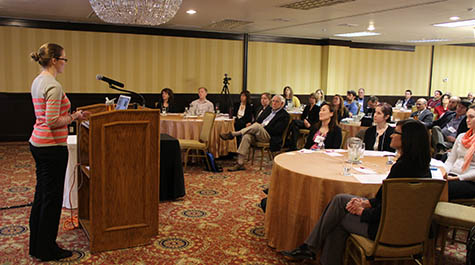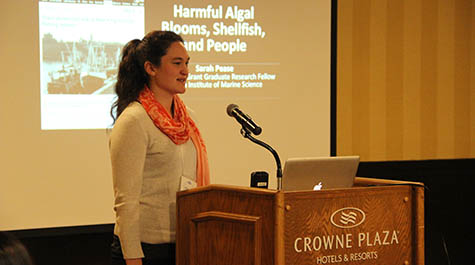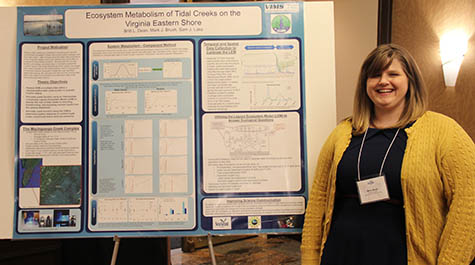Annual symposium turns breakout sessions into breakthroughs
Virginia Sea Grant promotes better collaborations, stronger projects
Researchers from the Virginia Institute of Marine Science traveled to the state capital in late January for Virginia Sea Grant’s 6th annual Project Participant’s Symposium at the Crowne Plaza in downtown Richmond.
During the daylong event, graduate students, faculty, members of the shellfish and fishing industries, NGO leaders, and representatives from several other institutions gave presentations and discussed current issues in Chesapeake Bay and coastal Virginia. The symposium also featured concurrent breakout sessions in an effort to put “integration in action.”
This year’s breakouts included sessions titled Dimensions of Resilience for Working Waterfronts and Starting Down the Path of Ecosystem-Based Fisheries Management for Oysters. “Virginia’s working waterfronts and waterways, including the infrastructure essential for water-dependent businesses and public uses, are under pressure from alternative waterfront uses," says VASG Director Troy Hartley. "Similarly, implementing ecosystem-based fisheries management has proven to be an intractable issue. Our sessions brought together thought leaders from all sectors and multiple disciplines to seek pathways forward on both of these critical issues for Virginia.”
As in past years, VIMS graduate students shared results from their studies in Chesapeake Bay and coastal Virginia. Master’s student Sarah Pease presented her project titled Harmful Algal Blooms, Shellfish, and People, while Ph.D. student Megan Wood presented Alternative Nursery Habitats for Juvenile Blue Crabs in Chesapeake Bay. The duo are fellows in VASG’s Graduate Research Fellowship Program, which funds coastal and marine science research graduate students throughout Virginia, including several other students in William & Mary’s School of Marine Science at VIMS.
“The research presentations given by the fellows highlight the valuable coastal and marine research VASG continually supports,” says Hartley. “The symposium also gives these talented graduate students an opportunity to present their science to an audience of people outside their respective fields, focusing on effective strategies for communicating their science.”
Because of the success of last year’s breakout sessions, VASG decided to place more of an emphasis on the breakouts to further enable integrated, collaborative problem-solving on pressing coastal and marine resource issues.
Skip Stiles, Executive Director of Wetlands Watch—a nonprofit environmental group based in Norfolk—was one of several presenters at the symposium who discussed the challenges of building successful collaborations and shared advice from their own experiences conducting a multi-institutional, resiliency design project.
During last year’s conference at the Science Museum of Virginia, Stiles led a breakout session on Climate Adaptation and Resilience Design in which participants helped lay the foundation for a resiliency-design project in a coastal community in Norfolk. At the time, Stiles was already exploring how the Chesterfield Heights community can best adapt to sea-level rise, before a storm might come and cause real damage.
Stiles says the progress they have made in Chesterfield Heights was framed by the conversations held during last year’s breakout session. Now, 20 Hampton University architecture students and 20 Old Dominion University engineering students are working together to develop a resiliency design that works for the community.
Stiles’ resiliency project is just one of several examples of the importance of collaboration across universities, state agencies, and other organizations that work in coastal Virginia.
Pease and Wood were selected as VASG fellows based on academic achievement, relevance of their research to VASG goals, and demonstrated interest in outreach activities. The research presented at the symposium highlights coastal and marine studies that are equally important to scientists, resource managers, industry, and other stakeholders.
Other speakers shared advice about collaborating with new partners and discussed the potential challenges of working across multiple disciplines. Some of the takeaways included the need to develop a deep understanding of other disciplines, language, and interests to ensure you’re on the same page with others, and involve end-users in the planning stages before a project begins.
“The symposium is one of Virginia Sea Grant’s foremost opportunities for integration and reflection,” says Hartley. “Integration and reflection is where innovation comes from, producing novel solutions to challenging coastal and marine resource issues.”
Attendees at the VASG symposium included representatives from Virginia Tech, the University of Virginia, Old Dominion University, the National Weather Service, NOAA Chesapeake Bay Office, the Virginia Department of Health, members of the shellfish and fishing industries, and many other institutions.




